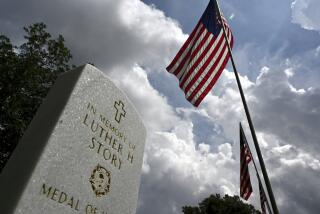Proving His Medal
- Share via
It took more than half a century--and two failed attempts--but Charles V. Kelsey can finally smile at the shiny Purple Heart in his hand.
“Gosh, it’s pretty,” said the 75-year-old Yorba Linda man as he admired the golden medal with his name engraved on the back. It was a honor he thought he’d never see, because for years he was told he lacked medical proof that his injuries were battle-related.
Kelsey earned the Purple Heart, awarded to any U.S. military personnel wounded or killed as a result of enemy attack, on April 13, 1945. It was only weeks before the Nazis surrendered, when the U.S. Army private and fellow soldiers came under enemy fire while transporting ammunition and an artillery gun near Hagen, Germany.
“I can still hear the pop-pop-pop of the sniper fire,” he said, recalling how the driver swerved to avoid the hostile fire, and the truck slid into a gully and overturned. Crates packed with shells fell on the seven soldiers inside. “It happened so quickly you had no time to think about it. . . . A lot of ammo fell on us, particularly on me.”
Kelsey was knocked unconscious and suffered injuries to his legs, leaving him partially paralyzed for weeks.
At the time, Kelsey didn’t consider applying for the Purple Heart that was due him. He was just thankful to be alive and focused on regaining the use of his legs.
“I wish I was home,” he remembered thinking while recuperating. “I’m glad to be alive and have all my body parts. . . . At that time, you just wish you can go on with your life.”
Kelsey was discharged in 1946 and moved to California, where he and his wife, Madeline, had three kids. Kelsey enjoyed a long career in education--as a teacher, counselor and administrator--until he retired in 1982. But his wish for a Purple Heart was always in the back of his mind.
“I just felt it was unfinished business. Something [was] incomplete in my military career,” he said.
Kelsey applied to the Army twice for the award, in 1974 and 1981, but despite submitting letters of recommendation from his commanding officer, his applications were denied as lacking sufficient evidence that his injuries were the direct result of enemy fire.
“I didn’t think I would ever get it,” Kelsey said.
Army medics never took X-rays of his wartime wounds, Kelsey said. During an unrelated medical procedure several years later, a doctor detected in an X-ray that Kelsey’s back had been broken years earlier--an injury he attributes to the wartime incident.
“He said it sure healed nicely,” Kelsey recalled.
While residing in Arizona, Kelsey requested help from Sen. John McCain (R-Ariz.), who had been a prisoner of war in Vietnam. Kelsey also boosted his chances with a letter confirming his injuries from the battalion surgeon who treated him in Germany. Kelsey had noticed the doctor’s name in his medical records and tracked down the elderly doctor in Philadelphia.
“That was more or less the clincher,” he said.
In January, Kelsey received a letter informing him that he would at last be awarded a Purple Heart.
When he read it, “he just broke down in tears,” Madeline Kelsey, 73, said.
He received the medal in July. Rep. Loretta Sanchez (D-Garden Grove) said she will pin the medal on Kelsey at a long-overdue ceremony on Sept. 1.
“He deserves a big salute and I’m going to give him one,” Sanchez said.
Kelsey said he is looking forward to it and is not at all bitter about the wait.
“I deserve it with what I went through,” he said. “It’s a closure to my military career. . . . It was one of those odd things that take many moons to get, but it finally arrives.”
(BEGIN TEXT OF INFOBOX / INFOGRAPHIC)
Distinguished decoration
Formally called the Badge of Military Merit, the Purple Heart was first awarded in 1782 to Revolutionary War soldiers for unusual bravery. The modern medal, established in 1932, is given to armed forces personnel wounded or killed in action.


